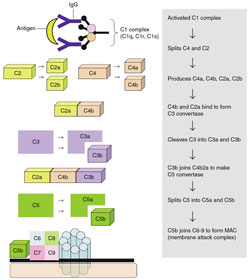Complement System
| Figure 1.7 Classical complement
pathway |
- Function to destroy invading microorganisms but leave host tissue intact; occurs via opsonization (complement proteins coat pathogenic organism to enhance phagocytosis) and direct membrane damage; plays role in both innate and adaptive immune system
- Complement cascade: proteins circulate as proenzymes, which upon activation are able to cleave/activate next protein in cascade; one enzyme can cleave many substrates, resulting in massive amplification
- Other roles include chemotaxis, immune complex solubilization and removal, B cell activation, and anaphylaxis (via degranulation of neutrophils and mast cells)
- Three complement pathways: classical, alternative, and mannose-binding lectin pathway
- All three pathways form membrane attack complex or MAC (C5b–C9), which is the cytolytic end-product of the complement pathway; MAC causes insertion of molecules into the lipid bilayer and forms pores (transmembrane channels), resulting in osmotic lysis of cell
- Classical pathway
- Proteins indicated by “C” followed by number, which reflects order in which activated; when complement protein cleaved, typically results in fragmentation and lower case letter (i.e., C4 b)
- Activated by antigen-antibody complex with IgM or IgG (IgG3 > IgG1 > IgG2)
| | | | | | Be able to distinguish proteins in classical and alternative pathway | | | | | |
|
- C1 consists of trimer with three proteins: C1q, C1r, and C1s
- Cascade involves three main steps: activation of C3 convertase, activation of C5 convertase, and formation of MAC
- Cascade: C1q binds to antigen-bound IgM or IgG (Ag-Ab complex) → activates C1r/C1s → C1s activates C2 and C4 (both cleaved into fragments: C2a/C2b, C4a/C4b) → C4b/C2a forms classical C3 convertase → C4b2a cleaves C3 (C3a/C3b) → C3b attaches to C3 convertase (C4b2a3b) forming classical C5 convertase → cleaves C5 → activates MAC formation → results in cell lysis
| | | | | | IgG4 does not cause classical pathway activation | | | | | |
|
- Activated by bacterial or viral products (i.e., LPS from gram-negative bacteria) in absence of antibody
- Alternative proteins: Factor B, Factor D, Factor H, C3 and properdin
- C3 spontaneously cleaved at low levels (into C3a and C3b fragments) → membrane-bound C3b binds to Factor B → Factor B cleaved by Factor D into Ba and Bb → Bb stays associated with C3b forming C3bBb (C3 convertase) → properdin stabilizes C3 convertase → C5 cleaved and MAC formation occurs
- Mannose-binding lectin pathway
- Triggered by interaction of microbial carbohydrates with mannose-binding proteins (in absence of antibody); end result is MAC formation
|
